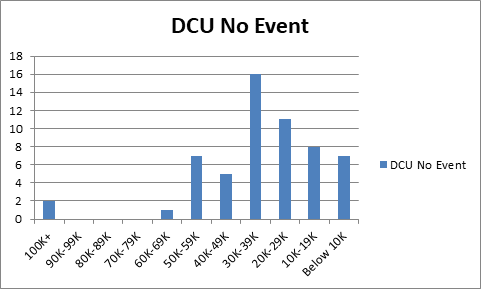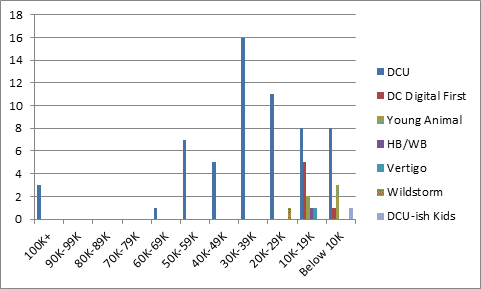The July sales estimates are out, so it’s time to take a look at the sales distribution charts and see where things fall in the market. As usual, we’ll start with DC.
Standard disclaimers: The numbers are based on the Diamond sales charts as estimated by the very reliable John Jackson Miller. These charts are pretty accurate for U.S. Direct Market sales with the following caveats: 1) you can add ~10% for UK sales, which are not reflected in these charts; 2) everyone’s best guess is you can add ~10% for digital sale – while some titles do sell significantly better in digital (*cough* Ms. Marvel *cough*), that’s the average rule of thumb; 3) it’s not going to include reorders from subsequent months, although reorders will show up in subsequent months if they’re high enough. So if you’re a monster seller in Southampton and the it took the US audience 3 weeks to reorder, it’s probably not going to be reflected here.
What’s a sales band? It’s another way to have a higher level view of the market. The general idea is to divide the market into bands of 10K copies sold and see how many issues are in each band. How many issues sold between 90-99K copies, 80-89K copies, etc. etc. In very broad terms, the market is healthier when there are several titles selling in the 70K-100K+ range because titles that move a lot of copies give the retailers some margin of error on their ordering. When you see titles selling in the 20-29K band and especially below, there’s a pretty good chance a lot of retailers aren’t ordering those titles for the shelf (pull box/pre-order only) or minimal shelf copies at best.
The good news: Batman seems to have stabilized above 100K (and really, The War of Jokes and Riddles seems to be a real improvement over previous arcs). Dark Days: The Casting clocked in at a bit over 128K as the second prelude to Metal, so things look favorable for that Event… which is good, because there’s plenty set to spin out of it. Down in the under 10K sales range, there’s some reorder activity with Batman and Dark Days. So the top of the chart is getting reinforced by reorders significant enough to chart in the top 300.
The Bad News: there’s still that gaping hole between Dark Days & Batman over 100K and All-Star Batman, which just barely got over 60K in the July estimates and raises the question of whether it will still be over 60K in August. There’s not much top list there. Vertigo has also almost disappeared from the top 300, with just the first issue of The American Way popping up in July. While they haven’t cancelled anything yet, the bottom of the Rebirth launches are starting to get pretty low. DC’s making it a point of pride that nothing’s been cancelled, but unless some of those titles are moving mass quantities somewhere like the Scholastic market, several titles are probably not long for the rack.
Let’s have a look at DC without Events… which is to say, without Dark Days.
Not a lot of change here from last month. The sweet spot for DC is in that 30-39K zone. While DC switched to a net revenue system for determining royalty thresholds back in ’14, does anybody know roughly what the threshold to trigger royalties payments is on single issues these days? Seems like the buzz at the time was that 35K in print sales through Diamond probably wasn’t going to cut it for royalties.
DC’s been in a stable holding pattern the last couple months. It’s just screaming for secondary relaunch, though. We’re still a ways off from the Metal spinoff books, so it’s a bit early to forecast sales on those. As distasteful as Doomsday Clock’s pairing of the Justice League and Watchmen is to a lot of folks, the market could really use another hit and that’s probably the most likely hit in the near term. Cancelling 4 books under the 20K point and replacing them with one in each in those sale bands from 60K – 99K would create at least a semblance of a top list and go a long way towards balancing that chart, but these days it isn’t so easy to sell over 60K as a single issue.
Want to learn more about how comics publishing and digital comics work? Try Todd’s book, Economics of Digital Comics or have a look at his horror detective series on Patreon.






Basically, the modern reader jumps quickly from title to title. Every month is a juggling act by these companies trying to juggle reader interest. “Try this new series!” “Read this spin-off!” “This relaunch is different than the last one!” Where do readers actually disappear to?
I sorta feel like 35,000 a month for a twice-a-month title is different from 35,000 a month for a once-a-month title, but I’m not sure these charts address that difference.
As Nick says, the modern reader jumps quickly from title to title… this must be exasperating for publishers, but on the side of the readers, comics are sometimes solicited for sale with one crearive team onboard, but that team gets switched out before the comic is printed. So you don’t get what you ordered.. It’s a new game; “fickle versus fickle’!
I wonder if people cared so much about changes in artists “back in the day”. Like I remember not liking it when Paris Cullens left Blue Beetle, but I didn’t stop buying it because of it.
Comments are closed.